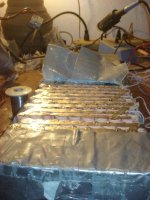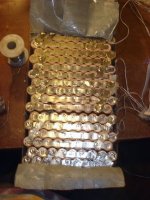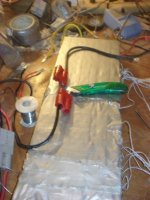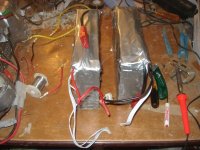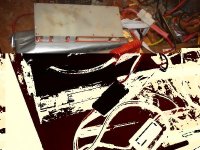I forgot to note the initial readings, but by the time I got done measuring groups, charging current is 2.79A, 51.76V. Peak current shows 2.89A, Vmin 48.9V, so I assume those are the initial values.
Klutzy hurty hands do not make for easy manipulation of probes, so it took several minutes to get the readings done, and I'm sure they don't represent starting charge states exactly because of that. Still, they show there is not a huge difference in any of the groups, really.
3.25
3.24
3.25
3.26
3.14
3.15
3.25
3.24
3.24
3.23
3.18
3.24
3.24
3.25
3.17
3.25
At almost 3A charge, it might take up to 6 hours to recharge it, assuming it does not shut off for balancing stages and that it took no more than 18Ah out of the pack.
I'm tempted to do the soldering during the charging, but I can imagine blowing up both charger and battery trying to do it. So I will probably stop charge for a bit and solder it up. I'll be leaving all the existing welds, too, just adding the solder for a greater surface area of connection between the nickel strips and the cells.
Klutzy hurty hands do not make for easy manipulation of probes, so it took several minutes to get the readings done, and I'm sure they don't represent starting charge states exactly because of that. Still, they show there is not a huge difference in any of the groups, really.
3.25
3.24
3.25
3.26
3.14
3.15
3.25
3.24
3.24
3.23
3.18
3.24
3.24
3.25
3.17
3.25
At almost 3A charge, it might take up to 6 hours to recharge it, assuming it does not shut off for balancing stages and that it took no more than 18Ah out of the pack.
I'm tempted to do the soldering during the charging, but I can imagine blowing up both charger and battery trying to do it. So I will probably stop charge for a bit and solder it up. I'll be leaving all the existing welds, too, just adding the solder for a greater surface area of connection between the nickel strips and the cells.




